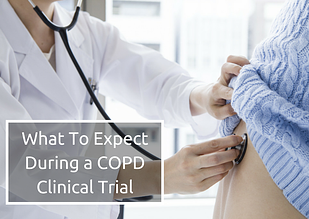If you or a loved one have COPD and aren’t happy with your current treatment or would like to learn if there are other options, a clinical trial maybe an opportunity to improve your quality of life and learn more about the illness.
Here is what you can expect if you or a family member decides to sign up for a COPD clinical trial:
Step One: Sign an Informed Consent Form

When a patient comes into a research site's office the staff provides the patient with an Informed Consent Form (ICF) which is written information about the trial and procedures.
Once the patient has sufficient time to read through the entire ICF, then this document is discussed in length with the patient. This is to ensure that the patient has a clear understanding about the trial and any questions or concerns regarding the trial or their participation is addressed with the patient by the physician and/or clinical research coordinator to the patients satisfaction.
The ICF will explain in a detailed manner the risks and benefits of their participation in the trial. The physician/clinical research coordinator will ensure that the patients understand that their participation is voluntary and that they have the option to drop out at any time for any reason. This process is to ensure that the patient has all the information needed to make an informed decision as to whether participating in a clinical research trial is right for them.
Once the patient has decided that they would like to volunteer to participate in the trial and all of the patient’s questions are answered, the patient will initial, sign and date the informed consent form verifying that they have understood what they have read and that they are volunteering to participate. A copy of the signed and dated informed consent will be given to the patient for future reference.
Step Two: The Screening Procedure
Step two is the phase where patients undergo various diagnostic tests and procedures to ensure they meet all the criteria for participation in the clinical research study.
The protocol is designed with a list of inclusionary criteria as well as exclusionary criteria that is put in place with the guidance of the FDA to ensure that the risks to the potential patient is minimized whereby the benefits out way these risks. Some of the criteria are based on the patients' past and current medical history as well as their medication history. Other criteria is based on the diagnostic procedures performed during the screening process, such as, blood work results, electrocardiogram results (EKG's) and pulmonary function testing.
Not everyone makes it through the screening phase and is eligible to participate in the trial. Protocol's are designed so that we will not enroll patients whose test results are outside of designated ranges, because the patient's welfare and safety comes first and foremost. This is why the screening process for a COPD clinical trial includes pulmonary function testing, blood work, EKGs, and other information from the patient’s medical history and surgical history. The patient's current health issues are also carefully reviewed. During this process the patient will inherently learn about their illness.
Patients will undergo a standard medical exam/check-up with a physician, as part of the protocol without any cost to them. Generally the screening procedures, blood work and pulmonary function testing are performed at the research facility's location. If there is special testing required, the patient may be sent to a nearby medical facility. This is all arranged by the research staff.
As part of research protocol, the pulmonary function results may be sent to what is called a “central reader.” This central reader is an independent pulmonary physician who reads all the results for the trial and makes their evaluation based on the test results. They will determine the eligibility of the patient. In fact, most of the COPD protocol's are designed with the Global Initiative for Chronic Obstructive Lung Disease (GOLD, 2011) criteria.
Another aspect of the screening process, is a "washout" period. Although not all protocols require a washout period, some protocols are designed to have this step. If the COPD clinical trial requires a "washout", it may be necessary for the patient to washout of a prohibited medication as per the protocol design. This washout period will allow their body time to wash out certain levels of some medications and prepare for entry into the trial.
Most COPD trials will allow patients to use a rescue inhaler (short acting bronchodilator), such as Albuterol or Ventolin, throughout the screening process and for the duration of the trial if needed for acute respiratory issues.
Step Three: Treatment
Once the screening process is over and it’s determined the patient is eligible, they then come in for their randomization visit. This visit is where the patient is placed on either a placebo treatment or the active treatment, depending on the study protocol’s design. This process is typically randomly assigned and is blinded to the clinical site staff as well as to the patient. The percentage of patients on placebo can vary for each trial, so a patient will need to consider this when determining their interest in participating in a trial.
During this visit, the patient will receive detailed instructions on the investigational product (inhaler or pill); when to take the investigational product, how to take the investigational product and how to keep track of their results.
The need to track information on the effectiveness of the investigational product is crucial. Often times, this involves learning to use an electronic or written diary. Patients learn the importance of not skipping doses and taking the investigational medication as directed. Routine appointments and assessments occur throughout the trial. If there are any issues, concerns or side effects, patients can call the staff anytime, 24-hours a day, 7 days a week.
Once the trial is over patients are instructed about how to return to their regular routines. If the investigational medication has been helpful, we encourage the subject to speak with their primary physician regarding alternative treatments that may be similar to the trial product. If the trial drug is already approved and on the market, then we let the patient know and they can request that their physician prescribe that medication for them.
If you'd like to learn more about improving your COPD treatment, download our white paper - Living With COPD: A Guide To Better Treatment and Improved Breathing.
If you're interested in participating in a COPD clinical trial, click the button below to learn more.
Share This Post
Recent Posts
- The Relationship Between Obesity and Obstructive Sleep Apnea March 27 2015
- Cardiovascular Outcome Clinical Trials March 27 2015
- Diabetic Peripheral Neuropathic Pain March 27 2015
- Are All Types of Cholesterol Bad? March 27 2015
- Blood Pressure: The Highs, the Lows, and Everything in Between March 27 2015
Categories
- Clinical Trials
- Cardiovascular Disease
- Diabetes
- Obesity
- Kidney Disease
- Hypertension
- Pain Management
- Vaccine
- Cholesterol
- Chronic Obstructive Pulmonary Disease
- Diabetic Peripheral Neuropathy
- Migraine
- Osteoarthritis
- Biologics
- COVID-19
- Gastroesophageal Reflux Disease
- Irritable Bowel Syndrome with Constipation
- Lyme Disease
- Nonalcoholic Steatohepatitis
- Respiratory Syncytial Virus




